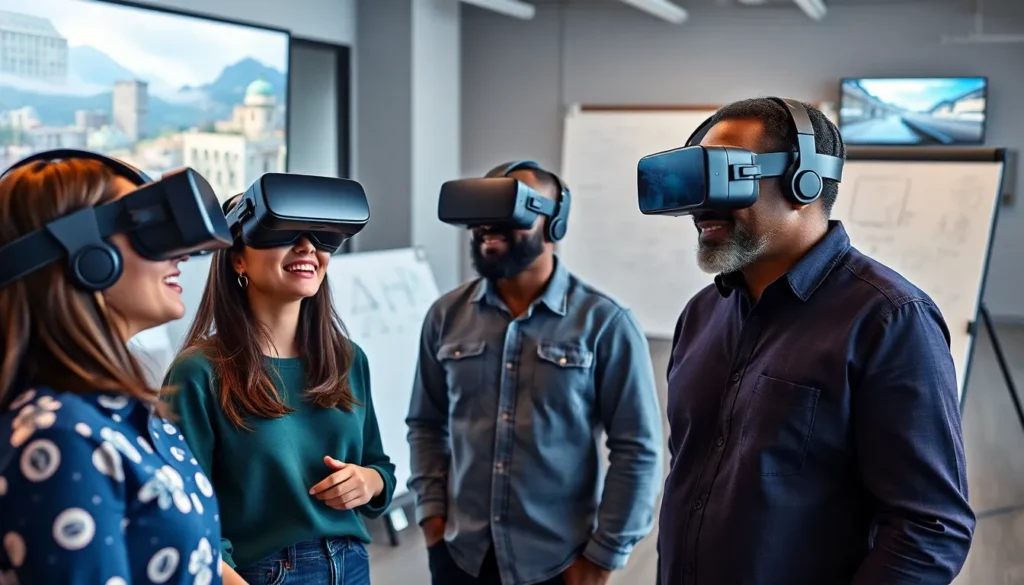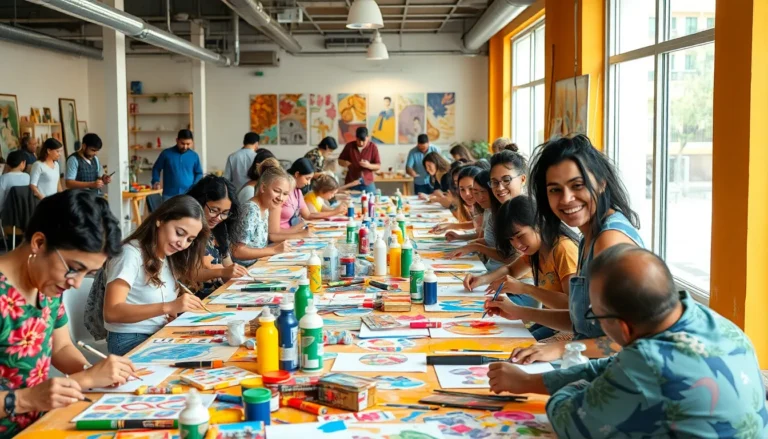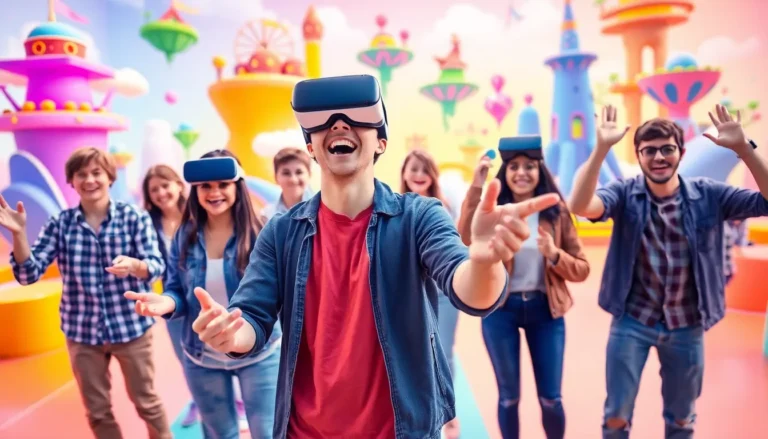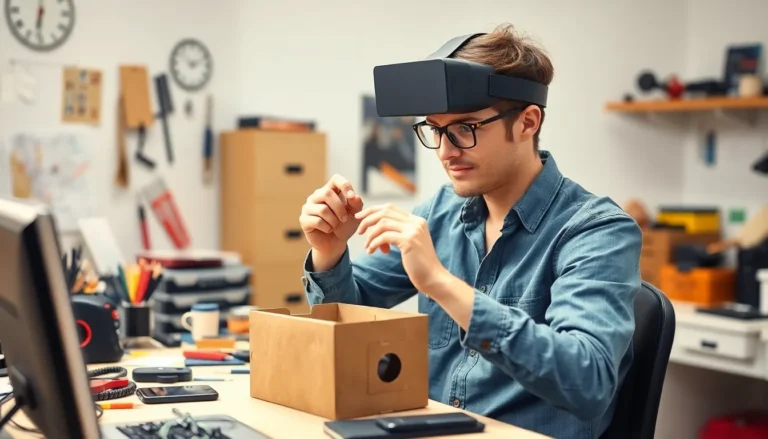Table of Contents
ToggleVirtual reality design isn’t just a buzzword; it’s the wild frontier of creativity. Imagine crafting entire worlds where users can escape the mundane and dive into experiences that tickle their imagination. Whether it’s a breathtaking mountain vista or a whimsical candy land, VR design transforms the ordinary into the extraordinary.
In this digital age, designers are no longer confined to flat screens. They’re sculptors of immersive experiences that engage all senses. As VR technology evolves, so does the potential for innovation. So grab your headset and get ready to explore how VR design is revolutionizing everything from gaming to education. Who knew playing with pixels could be this much fun?
Overview of VR Design
VR design encompasses the creation and development of immersive experiences using virtual reality technology. This field combines artistry, technology, and user experience principles to craft environments that captivate users. Designers explore various elements such as navigation, interaction, and visual aesthetics, ensuring engaging experiences.
User interfaces play a crucial role in VR design. Intuitive interfaces enhance usability, allowing users to interact seamlessly within virtual environments. Effective design promotes accessibility, enabling all users to engage fully with the content.
Tools for VR design vary widely. Software such as Unity and Unreal Engine empowers designers to develop realistic simulations. These platforms offer robust features for creating three-dimensional spaces, character animations, and interactive elements.
Designers also consider the importance of storytelling. Compelling narratives enhance user engagement, drawing users into the experience. Well-crafted stories create emotional connections, making VR experiences memorable.
Additionally, user feedback significantly impacts VR design. Gathering insights from users helps designers identify areas for improvement, refine interactions, and enhance overall experience quality. This iterative process fosters innovation and keeps designs relevant.
In various sectors, from gaming to education, VR design demonstrates versatility. Educational institutions leverage VR for simulations that offer hands-on learning experiences. Entertainment developers create immersive gaming worlds that challenge players in new ways.
Ultimately, VR design represents a convergence of creativity and technology, shaping the future of how individuals experience digital content.
Key Principles of VR Design
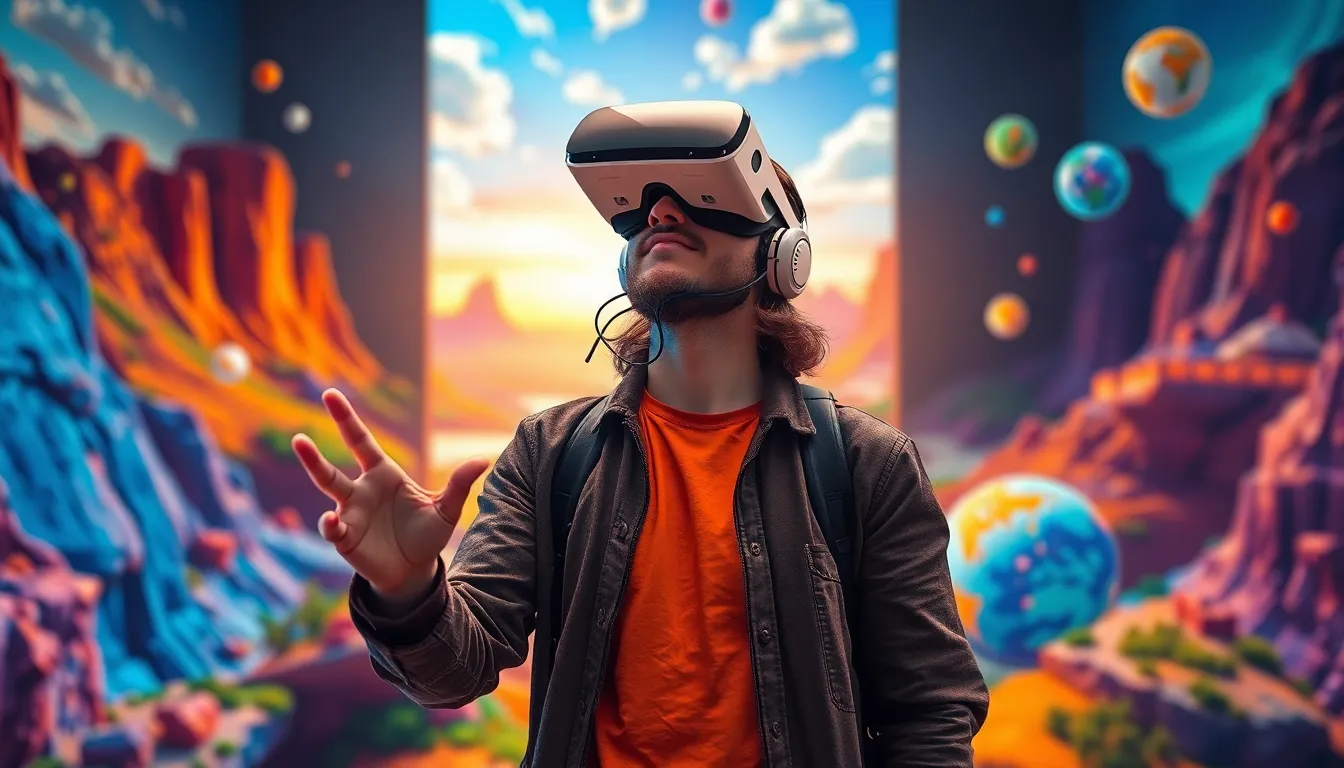
VR design prioritizes creating immersive experiences, focusing on user engagement through various principles. The essence of this field lies in how effectively it can transport users into virtual environments.
Immersion and Presence
Immersion refers to how deeply users feel enveloped in VR. Achieving this effect involves utilizing realistic visuals, spatial audio, and haptic feedback. Designers emphasize environmental details, ensuring users perceive depth and scale accurately. Presence stems from the user’s emotional connection to the virtual world. Enhanced presence generates a sense of being physically there, often through lifelike interactions and responsive elements. Research indicates that these factors significantly influence user satisfaction and experience quality.
Interaction Design
Interaction design centers on how users navigate and communicate within virtual spaces. Designers implement intuitive controls and gestures to ensure seamless movement throughout environments. Various input methods, like hand tracking and voice commands, contribute to fluid interactions. Clear feedback signals reinforce user actions, making the experience more enjoyable. Prioritizing simplicity ensures that everyone can engage without overwhelming complexity. Crafting meaningful interactions plays a crucial role in maintaining user interest and encouraging exploration.
Best Practices in VR Design
Effective VR design hinges on a few foundational practices. Focusing on the user experience ensures creations resonate with audiences.
User-Centered Design
User-centered design prioritizes the needs and preferences of users throughout the design process. Understanding users’ behaviors and motivations aids in creating engaging experiences. Designers conduct research through surveys and interviews to gather insights. Compiling feedback allows teams to refine interactions in real-time. Engaging users in the design phase fosters a sense of ownership. Usability testing reveals pain points, which leads to smoother navigation. Clarifying user personas shapes the development of tailored experiences that captivate audiences.
Prototyping and Testing
Prototyping and testing play critical roles in the VR design workflow. Rapid prototyping enables designers to build and iterate concepts quickly. Utilizing tools like Unity streamlines the creation of immersive environments. Testing prototypes with actual users uncovers unforeseen issues and improves functionality. Iterative testing refines interactions and visual elements. Collecting data during tests informs design decisions effectively. Analyzing user behavior reveals insights that enhance the overall experience. Addressing feedback leads to increased satisfaction and elevated engagement.
Tools and Technologies for VR Design
Numerous tools and technologies facilitate VR design, each contributing unique features. Unity serves as a prominent platform, providing a user-friendly interface for developing immersive experiences. Unreal Engine stands out with its high-fidelity graphics, enabling designers to create visually stunning environments.
Blender is essential for 3D modeling, allowing designers to craft detailed assets for VR applications. Many use SketchUp for quick and intuitive modeling, particularly in architectural design. Additionally, Adobe Medium helps artists sculpt and paint in a VR space, enhancing creative possibilities.
Software applications play a crucial role in user interaction. For instance, Vizard offers tools for rapid prototyping and usability testing, aiding in the iterative design process. Game engines integrate physics engines and AI algorithms, enhancing realism within virtual environments.
Surround sound technology enriches the audio experience, immersing users deeper into the VR world. Various devices support these technologies, including Oculus Rift, HTC Vive, and Valve Index, all providing differing input methods and immersion levels.
Collaboration tools like Frame.io allow teams to work together efficiently, regardless of location. Project management software assists in tracking timelines and managing resources effectively.
Developers also rely on community forums such as VR Chat for support and inspiration. Online resources, tutorials, and webinars provide guidance in mastering VR design tools.
Emerging technologies, including artificial intelligence and machine learning, are transforming VR design. These advancements streamline workflow processes and improve user customization, offering personalized experiences within virtual realms.
Future Trends in VR Design
Advancements in VR technology continuously shape the future of design. Increased accessibility to high-quality VR devices drives broader adoption among consumers. designers focus on enhancing realism through improved graphics and higher resolutions.
Greater integration of artificial intelligence enhances user experiences by personalizing interactions. Virtual environments frequently adapt to user behavior and preferences over time. Natural language processing fosters more intuitive communication between users and virtual characters, enriching the immersion.
Interactivity remains essential to future VR design trends. Gamification elements, such as rewards and progress tracking, increase user engagement. Social interactions within VR platforms facilitate shared experiences, allowing users to connect across distances.
Multi-sensory experiences are on the rise, with more designers exploring tactile and olfactory elements. Incorporating scent and touch enhances realism, making virtual environments more unforgettable. Notably, this integration encourages deeper emotional connections with users.
Sustainability plays a critical role in the development of VR applications. Designers now consider environmentally conscious practices and renewable resources. This approach fosters a sense of responsibility within the design community.
Collaborative tools facilitate teamwork among designers, developers, and stakeholders in real time. Cloud-based platforms streamline communication and version control. Enhanced collaboration paves the way for more innovative solutions and diverse ideas.
Furthermore, the growth of VR in education and training settings gains momentum. Educational institutions increasingly use VR simulations to provide hands-on learning experiences. This immersive educational approach enhances retention and engagement among learners.
As technology evolves, these trends redefine how designers create and users experience virtual realities. Each innovation expands creative possibilities, driving the field forward. The future of VR design holds immense potential for exciting developments and unparalleled experiences.
The future of VR design holds immense potential for innovation and creativity. As technology continues to advance, designers will have even more tools at their disposal to craft engaging and immersive experiences. The emphasis on user-centered design ensures that these experiences resonate with users on a deeper level, fostering emotional connections that enhance overall engagement.
Emerging trends like AI integration and multi-sensory elements will further transform how users interact with virtual environments. By prioritizing sustainability and collaboration, the VR design community is poised to create not only captivating worlds but also responsible and inclusive experiences. As this field evolves, it promises to redefine entertainment, education, and beyond, making it an exciting time for both designers and users alike.

